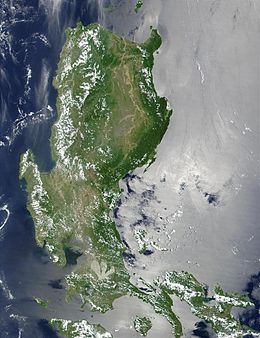 Luzon satellite image by NASA in 2005 Luzon satellite image by NASA in 2005 | |
| Geography | |
|---|---|
| Location | Southeast Asia |
| Coordinates | 16°N 121°E / 16°N 121°E / 16; 121 |
| Archipelago | Philippines |
| Adjacent to | |
| Major islands | |
| Area | 109,965 km (42,458 sq mi) |
| Area rank | 15th |
| Coastline | 3,249.6 km (2019.21 mi) |
| Highest elevation | 2,928 m (9606 ft) |
| Highest point | Mount Pulag |
| Administration | |
| Philippines | |
| Regions | List |
| Provinces |
List
|
| Largest settlement | Quezon City (pop. 2,960,048 ) |
| Demographics | |
| Demonym | Luzonian (modern) Luzonense (occasional) Luções/Luzones (archaic) |
| Population | 64,260,312 (2021) (estimate) |
| Pop. density | 490/km (1270/sq mi) |
| Ethnic groups | |
Luzon (/luːˈzɒn/ loo-ZON, Tagalog: [luˈson]) is the largest and most populous island in the Philippines. Located in the northern portion of the Philippine archipelago, it is the economic and political center of the nation, being home to the country's capital city, Manila, as well as Quezon City, the country's most populous city. With a population of 64 million as of 2021, it contains 52.5% of the country's total population and is the 4th most populous island in the world. It is the 15th largest island in the world by land area.
Luzon may also refer to one of the three primary island groups in the country. In this usage, it includes the Luzon Mainland, the Batanes and Babuyan groups of islands to the north, Polillo Islands to the east, and the outlying islands of Catanduanes, Marinduque and Mindoro, among others, to the south. The islands of Masbate, Palawan and Romblon are also included, although these three are sometimes grouped with another of the island groups, the Visayas.
Etymology

The name Luzon is thought to derive from ᜎᜓᜐᜓᜅ᜔ lusong, a Tagalog word referring to a particular kind of large wooden mortar used in dehusking rice. A 2008 research paper by Eulito Bautista and Evelyn Javier provides an image of a lusong, explaining:
Traditional milling was accomplished in the 1900s by pounding the palay with a wooden pestle in a stone or wooden mortar called lusong. The first pounding takes off the hull and further pounding removes the bran but also breaks most grains. Further winnowing with a bamboo tray (bilao) separates the hull from the rice grains. This traditional hand-pounding chore, although very laborious and resulted in a lot of broken rice, required two to three skilled men and women to work harmoniously and was actually a form of socializing among young folks in the villages.
In old Latin, Italian, and Portuguese maps, the island is often called "Luçonia" or "Luconia."
Luções, [luˈsõjʃ] (also Luzones in Spanish) was a demonym used by Portuguese sailors in Malaysia during the early 1500s, referring to the Kapampangan and Tagalog people who lived in Manila Bay, which was then called Lusong (Kapampangan: Lusung, Portuguese: Luçon), from which Luzon was also derived. The term was also used for Tagalog settlers in Southern Tagalog region, where they created intensive contact with the Kapampangans. Eventually, the term "Luzones" would refer to the settlers of Luzon island, and later on, would be exclusive to the peoples of Central Luzon.
History
Further information: History of Luzon, Tondo (historical polity), Cainta (historical polity), Namayan, Maynila (historical polity), Ma-i, and Pangasinan (historical polity)Before European colonization
Before 1000 CE, the Tagalog, Kapampangan, and Pangasinan peoples of south and central Luzon had established several major coastal polities, notably Maynila, Tondo and Namayan. The oldest known Philippine document, written in 900, is the Laguna Copperplate Inscription, which names places in and around Manila Bay and also mentions Medan, a place in Indonesia. These coastal Philippine kingdoms were thalassocracies, based on trade with neighboring Asian political entities, and structured by leases between chiefs or lords (Datu) and paramount lords (Lakan) or Rajahs, by whom tributes were extracted and taxes were levied.
There was also a Buddhist polity known as Ma-i or Maidh, described in Chinese and Bruneian records in the 10th century, although its location is still unknown and scholars are divided on whether it is in modern-day Bay, Laguna or Bulalacao, Mindoro.

According to sources at the time, the trade in large native Ruson-tsukuri (literally Luzon-made, Japanese:呂宋製) clay jars used for storing green tea and rice wine with Japan flourished in the 12th century, and local Tagalog, Kapampangan and Pangasinan potters had marked each jar with Baybayin letters denoting the particular urn used and the kiln the jars were manufactured in. Certain kilns were renowned over others; prices depended on the reputation of the kiln. Of this flourishing trade, the Burnay jars of Ilocos are the only large clay jar manufactured in Luzon today with origins from this time.
In the early 1300s the Chinese annals, Nanhai zhi, reported that Hindu Brunei invaded or administered Sarawak and Sabah as well as the Philippine kingdoms of Butuan, Sulu, and in Luzon: Ma-i (Mindoro) and Malilu 麻裏蘆 (present-day Manila); Shahuchong 沙胡重 (present-day Siocon or Zamboanga), Yachen 啞陳 Oton (Part of the Madja-as Kedatuan), and 文杜陵 Wenduling (present-day Mindanao), which would regain their independence at a later date.
In 1405, the Yongle Emperor appointed a Chinese governor of Luzon, Ko Ch'a-lao, during Zheng He's voyages. China also had vassals among the leaders in the archipelago. China attained ascendancy in trade with the area in Yongle's reign.
Afterwards, some parts of Luzon were Islamized when the former Majapahit province of Poni broke free, converted to Islam, and imported Sharif Ali, a prince from Mecca who became the Sultan of Brunei, a nation that then expanded its realms from Borneo to the Philippines and set up the Kingdom of Maynila as its puppet-state. The invasion of Brunei spread Chinese royal descent like Ong Sum Ping's kin and Arab dynasties too into the Philippines like the clan of Sultan Sharif Ali. However, other Luzon kingdoms resisted Islam, like Pangasinan. It had remained a tributary state of China and was a largely Sinified kingdom, which maintained trade with Japan. The Polity of Cainta also existed as a fortified city-state, armed with walls and cannons.
Interactions with the Portuguese
The Portuguese were the first European explorers who recorded it in their charts as Luçonia or Luçon, calling the inhabitants Luções. Edmund Roberts, who visited Luzon in the early 19th century, wrote that Luzon was "discovered" in 1521.
Many people from Luzon were employed within Portuguese Malacca. For example, the spice magnate Regimo de Raja, based in Malacca, was highly influential and was appointed as Temenggong (Sea Lord)—a governor and chief general responsible for overseeing of maritime trade—by the Portuguese. As Temenggong, de Raja was also the head of an armada which traded and protected commerce in the Indian Ocean, the Strait of Malacca, the South China Sea, and the medieval maritime principalities of the Philippines. His father and wife carried on his maritime trading business after his death. Another important Malacca trader was Curia de Raja who also hailed from Luzon. The "surname" of "de Raja" or "diraja" could indicate that Regimo and Curia, and their families, were of noble or royal descent as the term is an abbreviation of Sanskrit adiraja.
Fernão Mendes Pinto noted that a number of Luções in the Islamic fleets went to battle with the Portuguese in the Philippines during the 16th century. The Sultan of Aceh gave one of them (Sapetu Diraja) the task of holding Aru (northeast Sumatra) in 1540. Pinto also says one was named leader of the Malays remaining in the Moluccas Islands after the Portuguese conquest in 1511. Antonio Pigafetta notes that one of them was in command of the Brunei fleet in 1521. However, the Luções did not only fight on the side of the Muslims. Pinto says they were also apparently among the natives of the Philippines who fought the Muslims in 1538.
On Mainland Southeast Asia, Lusung/Luções warriors aided the Burmese king in his invasion of Siam in 1547. At the same time, Lusong warriors fought alongside the Siamese king and faced the same elephant army of the Burmese king in the defence of the Siamese capital at Ayutthaya. Luções military and trade activity reached as far as Sri Lanka in South Asia where Lungshanoid pottery made in Luzon were discovered in burials.
Scholars have thus suggested that they could be mercenaries valued by all sides.
Spanish Colonial Era

The Spanish arrival in the 16th century saw the incorporation of the Luções people and the breaking up of their kingdoms and the establishment of the Las Islas Filipinas with its capital Cebu, which was moved to Manila following the defeat of the local Rajah Sulayman in 1570. Under Spain, Luzon also came to be known as the Nueva Castilla or the New Castile.
In Spanish times, Luzon became the focal point for trade between the Americas and Asia. The Manila Galleons constructed in the Bicol region brought silver mined from Peru and Mexico to Manila. The silver was used to purchase Asian commercial goods like Chinese silk, Indian gems and Indonesian spices, which were then exported back to the Americas. The Chinese valued Luzon so much, in that when talking about Spain and the Spanish-Americas, they preferred to call it as "Dao Lusong" (Greater Luzon) while the original Luzon was referred to as "Xiao (Small) Lusong" to refer to not only Luzon but the whole Philippines.
Luzon also became a focal point for global migration. The walled city of Intramuros was initially founded by 1200 Spanish families. The nearby district of Binondo became the center of business and transformed into the world's oldest Chinatown. There was also a smaller district reserved for Japanese migrants in Dilao. Cavite City also served as the main port for Luzon and many Mexican soldiers and sailors were stationed in the naval garrisons there. When the Spanish evacuated from Ternate, Indonesia; they settled the Papuan refugees in Ternate, Cavite which was named after their evacuated homeland. After the short British Occupation of Manila, the Indian Sepoy soldiers that mutinied against their British commanders and joined the Spanish, then settled in Cainta, Rizal.
Newcomers who were impoverished Mexicans and peninsulares were accused of undermining the submission of the natives. In 1774, authorities from Bulacan, Tondo, Laguna Bay, and other areas surrounding Manila reported with consternation that discharged soldiers and deserters (from Mexico, Spain and Peru) were providing Indios military training for the weapons that had been disseminated all over the territory during the British war. There was also continuous immigration of Tamils and Bengalis into the rural areas of Luzon: Spanish administrators, native nobles, and Chinese businessmen imported them as slave labor during this period.
In the 1600s, Fr. Joaqin Martinez de Zuñiga, conducted a census of the Archdiocese of Manila which held most of Luzon under its spiritual care, and it had the following number of tributes, with each tribute representing a family of 6-7, and he reported 90,243 native Filipino tributes; 10,512 Chinese (Sangley) and mixed Chinese Filipino mestizo tributes; and 10,517 mixed Spanish Filipino mestizo tributes. Pure Spaniards are not counted as they are exempt from tribute. Out of these, Fr. Joaqin Martinez de Zuñiga estimated a total population count exceeding half a million souls.
People from the Philippines, primarily from Luzon, were recruited by France (then in alliance with Spain), first to defend Indo-Chinese converts to Christianity being persecuted by their native governments. Eventually, Filipino mercenaries helped the French conquer Vietnam and Laos and to re-establish Cambodia as a French Protectorate. This process culminated in the establishment of French Cochinchina, centered in Saigon.
After Spanish colonization
After many years of Spanish occupation and resistance to reform, the Andres Novales uprising occurred and it was inspired by the Latin American Wars of Independence. Novales' uprising was primarily supported by Mexicans living in the Philippines as well as immigrant Latinos from the now independent nations of Colombia, Venezuela, Peru, Chile, Argentina and Costa Rica. Although the uprising failed it inspired the Cavite Mutiny, the suppression of which, lead to the martyrdoms of Priests, Gomburza and the subsequent execution of the reformist and hero, Jose Rizal. Reeling against this, the Philippine Revolution against Spain erupted in Cavite and spread all throughout Luzon and the Philippines. Consequently, the First Philippine Republic was established in Malolos, Bulacan. In the meantime, Spain sold the Philippines to the United States and the First Philippine Republic resisted the United States in the Philippine–American War which the Republic's forces lost due to its diplomatic isolation (no foreign nation recognized the First Republic) as well as due to the numerical superiority of the American military. The Americans then set up the cool mountain city of Baguio as a summer retreat for its officials. The Americans also rebuilt the capital, Manila, and established American military bases in Olongapo and Angeles cities mainly Clark Airbase and Subic Naval Base.
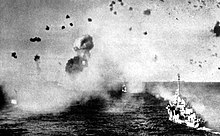
During the Pacific War, the Philippines were considered to be of great strategic importance because their capture by Japan would pose a significant threat to the U.S. As a result, 135,000 troops and 227 aircraft were stationed in the Philippines by October 1941. Luzon was captured by Imperial Japanese forces in 1942 during their campaign to capture the Philippines. General Douglas MacArthur—who was in charge of the defense of the Philippines at the time—was ordered to Australia, and the remaining U.S. forces retreated to the Bataan Peninsula.
A few months after this, MacArthur expressed his belief that an attempt to recapture the Philippines was necessary. The U.S. Pacific Commander Admiral Chester Nimitz and Chief of Naval Operations Admiral Ernest King both opposed this idea, arguing that it must wait until victory was certain. MacArthur had to wait two years for his wish; it was 1944 before a campaign to recapture the Philippines was launched. The island of Leyte was the first objective of the campaign, which was captured by the end of December 1944. This was followed by the attack on Mindoro and later, Luzon.
Further information: Battle of LuzonThe end of the World War necessitated decolonization due to rising nationalist movements across the world's many colonies. Subsequently, the Philippines gained independence from the United States. Luzon then arose to become the most developed island in the Philippines. However, the lingering poverty and inequality caused by the long dictatorship of US-supported dictator, Ferdinand Marcos, gave rise to the Philippine diaspora and many people from Luzon have migrated elsewhere and had established large overseas communities; mainly in the United States, Hong Kong, Singapore and Saudi Arabia. Eventually, the People Power Revolution led by Corazon Aquino and Cardinal Jaime Sin, removed Marcos and his cronies from power and they fled to Hawaii where the US granted them asylum. The following administrations are subsequently managing the political and economic recovery of the Philippines with the particular aim of spreading development outside of Luzon and into the more isolated provinces of the Visayas and Mindanao. During the administration of Ferdinand Marcos' son, Bongbong Marcos, Luzon became a destination of American and Japanese investments, it being the location of the Luzon Economic Corridor.
Geography
Further information: Geography of Luzon
Luzon island alone has an area of 109,964.9 square kilometres (42,457.7 sq mi), making it the world's 15th largest island. It is bordered on the west by the South China Sea (Luzon Sea in Philippine territorial waters), on the east by the Philippine Sea, and on the north by the Luzon Strait containing the Babuyan Channel and Balintang Channel. The mainland is roughly rectangular in shape and has the long Bicol Peninsula protruding to the southeast.
Luzon is roughly divided into four sections; Northern Luzon, Central Luzon, Southern Luzon, and Southeastern Luzon.
| Regions | Six divisions | Four divisions | Three divisions | Two divisions |
|---|---|---|---|---|
| Ilocos Region | Ilocandia | Northern Luzon | North and Central Luzon | North and Central Luzon |
| Cagayan Valley | ||||
| Cordillera Administrative Region | Cordilleras | |||
| Central Luzon | Central Luzon | |||
| National Capital Region | Metro Manila | Southern Luzon | ||
| Calabarzon | Southern Tagalog | Southern Luzon | Southern Luzon | |
| Mimaropa | ||||
| Bicol Region | Bicolandia | |||
Physical
Northern Luzon
The northwestern portion of the island, which encompasses most of the Ilocos Region, is characterized by a flat terrain extending east from the coastline toward the Cordillera Central mountains.
The Cordillera mountain range, which feature the island's north-central section, is covered in a mixture of tropical pine forests and montane rainforests, and is the site of the island's highest mountain, Mount Pulag, rising at 2,922 metres. The range provides the upland headwaters of the Agno River, which stretches from the slopes of Mount Data, and meanders along the southern Cordillera mountains before reaching the plains of Pangasinan.
The northeastern section of Luzon is generally mountainous, with the Sierra Madre, the longest mountain range in the country, abruptly rising a few miles from the coastline. Located in between the Sierra Madre and the Cordillera Central mountain ranges is the large Cagayan Valley. This region, which is known for being the second largest producer of rice and the country's top corn-producer, serves as the basin for the Cagayan River, the longest in the Philippines.
Along the southern limits of the Cordillera Central lies the lesser-known Caraballo Mountains. These mountains form a link between the Cordillera Central and the Sierra Madre mountain ranges, separating the Cagayan Valley from the Central Luzon plains.
Image gallery
-
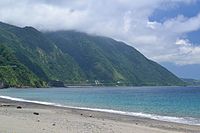 North coast of Luzon along the Cagayan-Ilocos Norte boundary
North coast of Luzon along the Cagayan-Ilocos Norte boundary
-
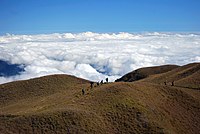 Summit of Mount Pulag, Luzon's highest mountain
Summit of Mount Pulag, Luzon's highest mountain
-
West coast of Luzon at San Juan overlooking the South China Sea
-
 The Cagayan Valley at Cabagan with the Sierra Madre mountains in the background
The Cagayan Valley at Cabagan with the Sierra Madre mountains in the background
-
 Canoes along upstream Cagayan River at Quirino province
Canoes along upstream Cagayan River at Quirino province
Central Luzon
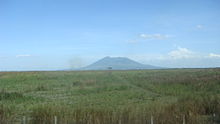
The central section of Luzon is characterized by a flat terrain, known as the Central Luzon plain, the largest in the island in terms of land area. The plain, approximately 11,000 square kilometres (4,200 sq mi) in size, is the country's largest producer of rice, and is irrigated by two major rivers; the Cagayan to the north, and the Pampanga to the south. In the middle of the plain rises the solitary Mount Arayat.
The western coasts of Central Luzon are typically flat extending east from the coastline to the Zambales Mountains, the site of Mount Pinatubo, made famous because of its enormous 1991 eruption. These mountains extend to the sea in the north, forming Lingayen Gulf, and to the south, forming the Bataan Peninsula. The peninsula encloses Manila Bay, a natural harbor considered to be one of the best natural ports in East Asia, due to its size and strategic geographical location.
The Sierra Madre mountain range continues to stretch across the western section of Central Luzon, snaking southwards into the Bicol Peninsula.
Southern Luzon
"Southern Luzon" redirects here. For the historical region, see Southern Tagalog. For the current regions, see Calabarzon and Mimaropa. 123456789 123456789 | ||||||||||||||||||||
| ||||||||||||||||||||
Southern Luzon is dominated by Laguna de Bay (Old Spanish, "Lake of Bay town"), the largest lake in the country. The 949-square-kilometre (366 sq mi) lake is drained into Manila Bay by the Pasig River, one of the most important rivers in the country due to its historical significance and because it runs through the center of Metro Manila.
Located 20 kilometres (12 mi) southwest of Laguna de Bay is Taal Lake, a crater lake containing the Taal Volcano, the smallest in the country. The environs of the lake form the upland Tagaytay Ridge, which was once part of a massive prehistoric volcano that covered the southern portion of the province of Cavite and the whole of Batangas province.
South of Laguna Lake are two solitary mountains, Mount Makiling in Laguna and Batangas provinces, and Mount Banahaw, the highest in the region of Calabarzon.
Southeastern Luzon
The southeastern portion of Luzon is dominated by the Bicol Peninsula, a mountainous and narrow region extending approximately 150 kilometres (93 mi) southeast from the Tayabas Isthmus in Quezon province to the San Bernardino Strait along the coasts of Sorsogon. The area is home to several volcanoes, the most famous of which is the 2,460-metre (8,070 ft) high symmetrically shaped Mayon Volcano in Albay province. The Sierra Madre range has its southern limits at Quezon province. Ultra-prominent mountains dot the landscape, which include Mount Isarog and Mount Iriga in Camarines Sur, and Mount Bulusan in Sorsogon.
The peninsula's coastline features several smaller peninsulas, gulfs and bays, which include Lamon Bay, San Miguel Bay, Lagonoy Gulf, Ragay Gulf, and Sorsogon Bay.
 The conical Mayon Volcano and the city of Legazpi in Albay province
The conical Mayon Volcano and the city of Legazpi in Albay province
Outlying islands
Several outlying islands near mainland Luzon are considered part of the Luzon island group. The largest include Palawan, Mindoro, Masbate, Catanduanes, Marinduque, Romblon and Polillo.
Further information: Island groups of the PhilippinesAdministrative divisions
The island is covered by 8 administrative regions, 30 provinces and, as of 2014, 68 cities (8 regions, 38 provinces and 71 cities if associated islands are included).
| Region (designation) |
Location | Population (2020) |
Area | Density | Regional center |
|---|---|---|---|---|---|
| Ilocos Region (Region I) |
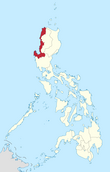
|
5,301,139 (4.9%) |
13,012.60 km (5,024.19 sq mi) |
410/km (1,100/sq mi) |
San Fernando (La Union) |
| Cagayan Valley (Region II) |
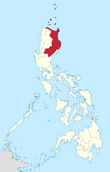
|
3,685,744 (3.4%) |
28,228.83 km (10,899.21 sq mi) |
130/km (340/sq mi) |
Tuguegarao |
| Central Luzon (Region III) |

|
12,422,172 (11.4%) |
22,014.63 km (8,499.90 sq mi) |
560/km (1,500/sq mi) |
San Fernando (Pampanga) |
| Calabarzon (Region IV-A) |
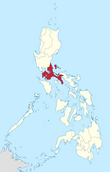
|
16,195,042 (14.9%) |
16,873.31 km (6,514.82 sq mi) |
960/km (2,500/sq mi) |
Calamba |
| Southwestern Tagalog Region (Mimaropa) |

|
3,228,558 (3.0%) |
29,620.90 km (11,436.69 sq mi) |
110/km (280/sq mi) |
Calapan |
| Bicol Region (Region V) |
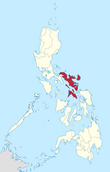
|
6,082,165 (5.6%) |
18,155.82 km (7,010.00 sq mi) |
330/km (850/sq mi) |
Legazpi |
| Cordillera Administrative Region (CAR) |

|
1,797,660 (1.6%) |
19,422.03 km (7,498.89 sq mi) |
93/km (240/sq mi) |
Baguio |
| National Capital Region (NCR) |
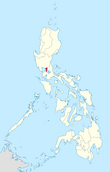
|
13,484,462 (12.4%) |
611.39 km (236.06 sq mi) |
22,000/km (57,000/sq mi) |
Manila |
Table note(s):
- Land area figures are the sum of each region's component provinces (and/or independent cities), derived from the National Statistical Coordination Board (Philippine Statistics Authority) official website.
- ^ The list includes the associated islands of Luzon (provinces of Marinduque, Occidental Mindoro, Oriental Mindoro, Palawan, Romblon, Batanes, Catanduanes and Masbate).
Tectonics
Main article: Philippine Mobile Belt
Luzon is part of the Philippine Mobile Belt, a fast deforming plate boundary zone (Gervasio, 1967) hemmed in between two opposing subduction zones, the west-dipping Philippine Trench-East Luzon Trench subduction zone, and the east-dipping north–south trending Manila Trench-Negros Trench-Cotabato Trench. The Philippine Sea Plate subducts under eastern Luzon along the East Luzon Trench and the Philippine Trench, while the South China Sea basin, part of the Eurasian Plate, subducts under western Luzon along the Manila Trench.
The North-Southeastern trending braided left-lateral strike-slip Philippine Fault System traverses Luzon, from Quezon province and Bicol to the northwestern part of the island. This fault system takes up part of the motion due to the subducting plates and produces large earthquakes. Southwest of Luzon is a collision zone where the Palawan micro-block collides with SW Luzon, producing a highly seismic zone near Mindoro island. Southwest Luzon is characterized by a highly volcanic zone, called the Macolod Corridor, a region of crustal thinning and spreading.
Using geologic and structural data, seven principal blocks were identified in Luzon in 1989: the Sierra Madre Oriental, Angat, Zambales, Central Cordillera of Luzon, Bicol, and Catanduanes Island blocks. Using seismic and geodetic data, Luzon was modeled by Galgana et al. (2007) as a series of six micro blocks or micro plates (separated by subduction zones and intra-arc faults), all translating and rotating in different directions, with maximum velocities ~100 mm/yr NW with respect to Sundaland/Eurasia.
Demographics
| Year | Pop. | ±% p.a. |
|---|---|---|
| 1903 | 4,101,516 | — |
| 1918 | 5,397,401 | +1.85% |
| 1939 | 8,165,778 | +1.99% |
| 1948 | 9,876,263 | +2.14% |
| 1960 | 14,061,448 | +2.99% |
| 1970 | 19,688,100 | +3.42% |
| 1975 | 22,790,274 | +2.98% |
| 1980 | 26,080,694 | +2.73% |
| 1990 | 33,357,887 | +2.49% |
| 1995 | 38,249,776 | +2.60% |
| 2000 | 42,822,686 | +2.45% |
| 2007 | 49,799,956 | +2.10% |
| 2010 | 52,362,999 | +1.84% |
| 2015 | 57,470,097 | +1.79% |
| 2020 | 62,196,942 | +1.57% |
| Source: National Statistics Office | ||
As of the 2015 census, the population of Luzon Island is 57,470,097 people, making it the 4th most populated island in the world.
Cities

Metro Manila is the most populous of the 3 defined metropolitan areas in the Philippines and the 11th most populous in the world. as of 2007, census data showed it had a population of 11,553,427, comprising 13% of the national population. Including suburbs in the adjacent provinces (Bulacan, Cavite, Laguna, and Rizal) of Greater Manila, the population is around 21 million.
| Largest cities in Luzon PSA Census May 2020 | |||||||||
|---|---|---|---|---|---|---|---|---|---|
| Rank | Name | Region | Pop. | Rank | Name | Region | Pop. | ||
 Quezon City  Manila |
1 | Quezon City | National Capital Region | 2,960,048 | 11 | San Jose del Monte | Central Luzon | 651,813 |  Caloocan  Taguig |
| 2 | Manila | National Capital Region | 1,846,513 | 12 | Las Piñas | National Capital Region | 606,293 | ||
| 3 | Caloocan | National Capital Region | 1,661,584 | 13 | Muntinlupa | National Capital Region | 543,445 | ||
| 4 | Taguig | National Capital Region | 1,261,738 | 14 | Calamba | Calabarzon | 539,671 | ||
| 5 | Antipolo | Calabarzon | 887,399 | 15 | Imus | Calabarzon | 496,794 | ||
| 6 | Pasig | National Capital Region | 803,159 | 16 | Angeles | Central Luzon | 462,928 | ||
| 7 | Valenzuela | National Capital Region | 714,978 | 17 | Marikina | National Capital Region | 456,059 | ||
| 8 | Dasmariñas | Calabarzon | 703,141 | 18 | General Trias | Calabarzon | 450,583 | ||
| 9 | Parañaque | National Capital Region | 689,992 | 19 | Pasay | National Capital Region | 440,656 | ||
| 10 | Bacoor | Calabarzon | 664,625 | 20 | Mandaluyong | National Capital Region | 425,758 | ||

(2015 Census, 100,000+ inhabitants)
Ethnic groups
Further information: Ethnic groups of the Philippines
Seven major Philippine ethnolinguistic groups predominate Luzon. Ilocanos and Pangasinenses dominate northern Luzon, particularly in the Ilocos Region to parts of the Cagayan Valley, while Kapampangans, Tagalogs, Ilocanos, and Sambals populate Central Luzon. Tagalogs dominate the National Capital Region, Calabarzon and the island provinces of Marinduque, Mindoro and extending to parts of Palawan and northern Bicol Peninsula, while Bicolanos populate the Bicol peninsula. Visayans, such as Masbateños, Romblomanons, Waray Sorsogonons, Cuyunons, mainly populate in the southern Bicol peninsula and island provinces of Masbate, Romblon, and Palawan.
Other ethnic groups lesser in population include the Aetas of Zambales and Bataan, the Ibanags of Cagayan and Isabela, the Gaddang of Nueva Vizcaya, the Igorot of the Cordilleras, and the Mangyans of Mindoro.
Due to historical centuries-old migrations, populations of ethnic Chinese Filipinos, Spanish Filipinos, Japanese Filipinos, Indian Filipinos, and Muslim Moros from Mindanao have also been present in urban areas. Historical mixed mestizo populations, particularly Chinese mestizos (mestizo de Sangley) and Spanish mestizos, and more recent mixed mesitzos of Americans, Japanese, Koreans, Indians (mostly Punjabis), and Arabs are also occasionally present. The historical Sangley Chinese and their pure and mixed-mestizo descendants are spread all across Luzon of several generations across the centuries. According to old Spanish censuses, around 1/3rd of the population of Luzon are mestizo admixed with either or both Southern Han Chinese (mostly from Manila to Pampanga) and/or Hispanic (Spanish or Latino) descent (Mostly in Cavite and Manila). Most Americans have settled in Central Luzon's highly urbanized cities of Angeles and Olongapo due to the former presence of the U.S. air and naval bases (Clark & Subic) there, while a majority of the Koreans and Japanese have mainly settled in the major cities and towns like Koreatown in Angeles City and Baguio and Subic.
Languages
Main article: Languages of the Philippines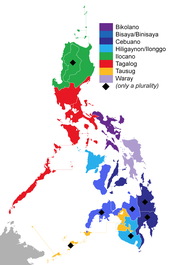
Almost all of the languages of Luzon belong to the Philippine group of the Malayo-Polynesian branch of the Austronesian language family. Major regional languages include: Tagalog, Ilocano, Central Bikol, Kapampangan, and Pangasinan.
English is spoken by many inhabitants. The use of Spanish as an official language declined following the American occupation of the Philippines. Almost inexistent among the general populace, Spanish is still used by the elderly of some families of great tradition (Rizal, Liboro...).

Religion
Main article: Religion in the PhilippinesLike most of the Philippines, the major religion in Luzon is Christianity, with Roman Catholicism being the major denomination. Other major sects includes Jehovah's Witnesses, Protestantism, the Philippine Independent Church (Aglipayans), the Church of Jesus Christ of Latter-day Saints (Mormons), and the Iglesia ni Cristo. Indigenous traditions and rituals, though rare, are also present.
There are also sizable communities of Hindus, Buddhists and Muslims in Metro Manila and in other, especially, urban areas due to the immigration of Moros and Chinese to the island.

Economy
The economy of the island is centered in Metro Manila with Makati serving as the main economic and financial hub. Major companies such as Ayala, Jollibee Foods Corporation, SM Group, and Metrobank are based in the business hubs of Makati Central Business District, Ortigas Center, and Bonifacio Global City. Industry is concentrated in and around the urban areas of Metro Manila while agriculture predominates in the other regions of the island producing crops such as rice, bananas, mangoes, coconuts, pineapple, and coffee. Other sectors include livestock raising, tourism, mining, and fishing.
See also
Notes
- ^ Figure composed of the eight administrative regions excluding the island provinces of Batanes, Catanduanes, and Masbate and the region MIMAROPA.
References
- ^ "Islands of Philippines". Island Directory Tables. United Nations Environment Programme. Archived from the original on April 28, 2019. Retrieved April 18, 2016.
- ^ Census of Population (2020). Table B - Population and Annual Growth Rates by Province, City, and Municipality - By Region. Philippine Statistics Authority. Retrieved July 8, 2021.
- ^ Census of Population (2015). Highlights of the Philippine Population 2015 Census of Population. Philippine Statistics Authority. Retrieved June 20, 2016.
- Boquet, Yves (2017). The Philippine Archipelago. Springer. p. 16. ISBN 9783319519265. Archived from the original on March 26, 2023. Retrieved December 22, 2018.
- Zaide, Sonia M. The Philippines, a Unique Nation. p. 50.
- Ooi, Keat Gin (2004). Southeast Asia: A Historical Encyclopedia, from Angkor Wat to East Timor. ABC-CLIO. p. 798. ISBN 978-1-57607-770-2. Archived from the original on March 26, 2023. Retrieved September 15, 2020.
- ^ Roberts, Edmund (1837). Embassy to the Eastern Courts of Cochin-China, Siam, and Muscat. New York: Harper & Brothers. p. 59. Archived from the original on October 15, 2013. Retrieved October 15, 2013.
- ^ Bautista, Eulito U.; Javier, Evelyn F. (2008). "Rice Production Practices: PIDS Research Paper Series 2008-02" (PDF). Philippine Institute of Development Studies Research Papers Series. Philippine Institute of Development Studies: 44. Archived from the original (PDF) on August 15, 2017. Retrieved May 29, 2019.
- Van Linschoten, Jan Huygen (1596). "Exacta & Accurata Delineatio cum Orarum Maritimarum tum etjam locorum terrestrium quae in Regionibus China, Cauchinchina, Camboja sive Champa, Syao, Malacca, Arracan & Pegu". Barry Lawrence Ruderman Antique Maps Inc. Archived from the original on September 1, 2019. Retrieved June 16, 2021.
- Quad, Matthias; Bussemachaer, Johann (1598). "Asia Partiu Orbis Maxima MDXCVIII". Barry Lawrence Ruderman Antique Maps Inc. Archived from the original on September 1, 2019. Retrieved June 16, 2021.
- Hondius, Jodocus (1606). "India Orientalis". Barry Lawrence Ruderman Antique Maps Inc. Archived from the original on June 24, 2021. Retrieved June 16, 2021.
- Jansson, Jan (1630). "Indiae Orientalis Nova Descriptio". Barry Lawrence Ruderman Antique Maps Inc. Archived from the original on June 24, 2021. Retrieved June 16, 2021.
- Blaeu, Willem Janszoon (1642). "India quae Orientalis dicitur et Insulae Adiacentes". Barry Lawrence Ruderman Antique Maps Inc. Archived from the original on June 24, 2021. Retrieved June 16, 2021.
- Blaeu, Willem Janszoon (1635). "Asia Noviter Delineata". Barry Lawrence Ruderman Antique Maps Inc. Archived from the original on June 24, 2021. Retrieved June 16, 2021.
- Hondius, Henricus (1636). "India quae Orientalis dicitur et Insulae Adiacentes". Barry Lawrence Ruderman Antique Maps Inc. Archived from the original on June 24, 2021. Retrieved June 16, 2021.
- Mariette, Pierre (1650). "Carte Generale Des Indes Orientales et des Isles Adiacentes". Barry Lawrence Ruderman Antique Maps Inc. Archived from the original on June 24, 2021. Retrieved June 16, 2021.
- Alfonso, Ian Christopher B. (2016). The Nameless Hero: Revisiting the Sources on the First Filipino Leader to Die for Freedom. Angeles: Holy Angel University Press. ISBN 9789710546527.
- ^ Scott, William Henry (1994). Barangay: Sixteenth Century Philippine Culture and Society. Quezon City: Ateneo de Manila University Press. ISBN 971-550-135-4.
- ^ Pires, Tomé (1944). A suma oriental de Tomé Pires e o livro de Francisco Rodriguez: Leitura e notas de Armando Cortesão [The Summa Oriental of Tomé Pires and the book by Francisco Rodriguez: Reading and notes by Armando Cortesão ] (in Portuguese). Translated by Cortesão, Armando. Cambridge: Hakluyt Society.
- ^ Lach, Donald Frederick (1994). "Chapter 8: The Philippine Islands". Asia in the Making of Europe. Chicago: University of Chicago Press. ISBN 0-226-46732-5.
- ^ Reid, Anthony (1995). "Continuity and Change in the Austronesian Transition to Islam and Christianity". In Peter Bellwood; James J. Fox; Darrell Tryon (eds.). The Austronesians: Historical and comparative perspectives. Canberra: Department of Anthropology, The Australian National University. doi:10.22459/A.09.2006. ISBN 978-0-7315-2132-6. Archived from the original on September 2, 2007. Retrieved August 30, 2015.
- Zorc, David (1993). "The Prehistory and Origin of the Tagalog People". In Øyvind Dahl (ed.). Language - a doorway between human cultures : tributes to Dr. Otto Chr. Dahl on his ninetieth birthday (PDF). Oslo: Novus. pp. 201–211.
- Morrow, Paul. "Laguna Copperplate Inscription". Mts.net. Archived from the original on February 5, 2008. Retrieved December 19, 2010.
- Go, Bon Juan (2005). "Ma'I in Chinese Records – Mindoro or Bai? An Examination of a Historical Puzzle". Philippine Studies. 53 (1): 119–138. Archived from the original on October 21, 2013.
- Scott, William Henry (1989). "Societies in Prehispanic Philippines". Prehispanic Source Materials for the Study of Philippine History. Quezon City: New Day Publishers. ISBN 978-9711002268.
- Potet, Jean-Paul G. (2013). Arabic and Persian Loanwords in Tagalog. Lulu.com. p. 444. ISBN 9781291457261.
- Manansala, Paul Kekai (September 5, 2006). "Quests of the Dragon and Bird Clan: Luzon Jars (Glossary)". Quests of the Dragon and Bird Clan. Archived from the original on September 4, 2007. Retrieved December 19, 2010.
- South East Asia Pottery – Philippines. Seapots.com. Retrieved on 2010-12-19. Archived October 19, 2014, at the Wayback Machine
- Reading Song-Ming Records on the Pre-colonial History of the Philippines Archived February 13, 2023, at the Wayback Machine By Wang Zhenping Page 256.
- Ptak, Roderich (1998). "From Quanzhou to the Sulu Zone and beyond: Questions Related to the Early Fourteenth Century". Journal of Southeast Asian Studies. 29 (2): 280. doi:10.1017/S002246340000744X. JSTOR 20072046. S2CID 162707729.
- Ho 2009, p. 33.
- Karnow 2010, p. 84.
- Encyclopædia Britannica, Volume 9. Contributor: Walter Yust. EncyclopÆdia Britannica. 1954. p. 75. Archived from the original on March 26, 2023. Retrieved June 21, 2019.
{{cite book}}: CS1 maint: others (link) - "Philippine Almanac & Handbook of Facts" 1977, p. 59.
- Frans Welman (August 1, 2013). Borneo Trilogy Brunei: Vol 1. Booksmango. pp. 8–. ISBN 978-616-222-235-1.
- Scott, William Henry (1989). "Filipinos in China in 1500" (PDF). Asian Studies. 21: 8. Archived from the original (PDF) on July 24, 2015. Retrieved June 10, 2015.
- Pires, Tomé, A suma oriental de Tomé Pires e o livro de Francisco Rodriguez: Leitura e notas de Armando Cortesão , translated and edited by Armando Cortesao, Cambridge: Hakluyt Society, 1944.
- Antony, Robert J. Elusive Pirates, Pervasive Smugglers: Violence and Clandestine Trade in the Greater China Seas. Hong Kong: Hong Kong University Press, 2010. Print, 76.
- Junker, Laura L. Raiding, Trading, and Feasting: The Political Economy of Philippine Chiefdoms. Honolulu: University of Hawaiì Press, 1999.
- Wilkinson, R J. An Abridged Malay-English Dictionary (romanised). London: Macmillan and Co, 1948. Print, 291.
- Junker, 400. http://sambali.blogspot.com/2014/12/the-borneo-route.html Archived August 3, 2015, at the Wayback Machine
- ^ Pinto, Fernão Mendes (1989) . The Travels of Mendes Pinto. Translated by Catz, Rebecca D. Chicago: University of Chicago Press. ISBN 9780226669519.
- Pigafetta, Antonio (1969) . First voyage round the world. Primo viaggio intorno al globo terraqueo.English. Translated by J.A. Robertson. Manila: Filipiniana Book Guild. Archived from the original on June 22, 2019. Retrieved June 22, 2019.
- Pigafetta 1969, p. 195.
- "Quest of the Dragon and Bird Clan; The Golden Age (Volume III)" -Lungshanoid (Glossary)- By Paul Kekai Manansala
- Chinese in Mexico by Chao Romero, pages 203 to 205
- Barrows, David P. (1905). A History of the Philippines. New York: American Book Company. p. 179. Archived from the original on February 8, 2019. Retrieved October 12, 2018 – via Guttenburg.
Within the walls, there were some six hundred houses of a private nature, most of them built of stone and tile, and an equal number outside in the suburbs, or "arrabales," all occupied by Spaniards ("todos son vivienda y poblacion de los Españoles"). This gives some twelve hundred Spanish families or establishments, exclusive of the religious, who in Manila numbered at least one hundred and fifty, the garrison, at certain times, about four hundred trained Spanish soldiers who had seen service in Holland and the Low Countries, and the official classes.
- See, Stanley Baldwin O. (November 17, 2014). "Binondo: New Discoveries in the World's Oldest Chinatown". GMA News Online. Archived from the original on August 18, 2020. Retrieved October 12, 2018.
- Galaup "Travel Accounts" page 375.
- Mehl, Eva Maria (2016). Forced Migration in the Spanish Pacific World: From Mexico to the Philippines, 1765–1811. Cambridge: Cambridge University Press. p. 235. doi:10.1017/cbo9781316480120. ISBN 978-1-316-48012-0.
- "Eva Maria Mehl: Forced migration in the Spanish pacific world: From Mexico to the Philippines, 1765–1811" Page 100. Archived May 16, 2022, at the Wayback Machine From the original Spanish language source in the archives of Mexico: "CSIC ser. Consultas riel 208 leg.14 (1774)"
- Peasants, Servants, and Sojourners: Itinerant Asians in Colonial New Spain, 1571–1720 By Furlong, Matthew J. Archived April 29, 2022, at the Wayback Machine "Slaves purchased by the indigenous elites, Spanish and Hokkiens of the colony seemed drawn most often from South Asia, particularly Bengal and South India, and less so, from other sources, such as East Africa, Brunei, Makassar, and Java..." Chapter 2 "Rural Ethnic Diversity" Page 164 Translated from: "Inmaculada Alva Rodríguez, Vida municipal en Manila (siglos xvi–xvii) (Córdoba: Universidad de Córdoba, 1997), 31, 35–36."
- ^ "ESTADISMO DE LAS ISLAS FILIPINAS TOMO PRIMERO By Joaquín Martínez de Zúñiga (Original Spanish)" (PDF). Archived (PDF) from the original on March 9, 2016. Retrieved February 3, 2024.
- Nigel Gooding, Filipino Involvement in the French-Spanish Campaign in Indochina, archived from the original on August 3, 2020, retrieved July 4, 2008
- Garcia de los Arcos has noted that the Regiment of the King, which had absorbed a large percentage of Mexican recruits and deportees between the 1770s and 1811, became the bastion of discontent supporting the Novales mutiny. ~Garcia de los Arcos, "Criollismo y conflictividad en Filipinas a principios del siglo XIX," in El lejano Oriente espanol: Filipinas ( ˜ Siglo XIX). Actas, ed. Paulino Castaneda ˜ Delgado and Antonio Garcia-Abasolo Gonzalez (Seville: Catedra General Casta ´ nos, ˜ 1997), 586.
- "Filipino-Mexican-South American Connection". filipinokastila.tripod.com. Archived from the original on February 25, 2021. Retrieved February 17, 2021.
- Vidal, Gore; Nielsen, David. "Death in the Philippines | David Nielsen". The New York Review of Books. Archived from the original on October 23, 2022. Retrieved October 23, 2022.
- "Clark Air Base History". Clarkab.org. Archived from the original on January 3, 2019. Retrieved July 14, 2009.
- ^ "The Philippines". Archived from the original on February 22, 2009. Retrieved December 6, 2008.
- Luzon Economic Corridor project draws foreign investments – Marcos By Filane Mikee Cervantes
- Smith, Robert Ross (1993). Triumph in the Philippines (Transcribed and formatted by Jerry Holden for the HyperWar Foundation). Honolulu, HI: University Press of the Pacific. p. 450. ISBN 1410224953. Archived from the original on January 25, 2015. Retrieved December 25, 2014.
- "PSGC Interactive; List of Provinces". Philippine Statistics Authority. Archived from the original on January 11, 2013. Retrieved April 3, 2016.
- "PSGC Interactive; List of Cities". Philippine Statistics Authority. Archived from the original on April 29, 2011. Retrieved April 7, 2016.
- Hashimoto, M, ed., Accretion Tectonics in the Circum-Pacific Regions, ISBN 90-277-1561-0 p299
- Rangin and Pubellier in Tectonics of Circum-Pacific Continental Margins ISBN 90-6764-132-4 p148 fig 4
- Census of Population and Housing (2010). Population and Annual Growth Rates for The Philippines and Its Regions, Provinces, and Highly Urbanized Cities (PDF). National Statistics Office. Retrieved June 29, 2016.
- ^ Philippine Statistics Authority (April 2008). "Total Population and Annual Population Growth Rates by Region: Population Censuses 1995, 2000, and 2007". Archived from the original on July 16, 2012. Retrieved April 4, 2010.
- Demographia. (July 2010). Demographia World Urban Areas (World Agglomerations) Population & Projections Archived May 3, 2018, at the Wayback Machine (Edition 6.1). Retrieved March 29, 2011.
- Census of Population (2015). Highlights of the Philippine Population 2015 Census of Population. Philippine Statistics Authority. Retrieved June 20, 2016.
- "Indian Express (2016)". May 18, 2016. Archived from the original on March 3, 2020. Retrieved February 4, 2023.
- Jagor, Fëdor, et al. (1870). The Former Philippines thru Foreign Eyes Archived January 9, 2021, at the Wayback Machine
- PHILIPPINES: ADDITIONAL THREE PERSONS PER MINUTE Archived 2016-03-05 at the Wayback Machine, National Statistics Office Archived 2013-10-04 at the Wayback Machine. Last revised: July 18, 2003. Retrieved November 27, 2006.
- "Index of Agriculture and Fishery Statistics". National Statistics Office. Archived from the original on February 21, 2012. Retrieved December 19, 2010.
Further reading
- Agoncillo, Teodoro A.; Guerrero, Milagros (1975). History of the Filipino People (4 ed.). R. P. Garcia. ISBN 9712345386. Retrieved April 24, 2014.
- Agoncillo, Teodoro A. (1962). Philippine History. Inang Wika Publishing Company. ISBN 9712345386. Retrieved April 24, 2014.
- Alip, Eufronio Melo (1954). Political and Cultural History of the Philippines, Volumes 1-2 (revised ed.). Alip & Sons. Retrieved April 24, 2014.
- Antonio, Eleanor D.; Dallo, Evangeline M.; Imperial, Consuelo M.; Samson, Maria Carmelita B.; Soriano, Celia D. (2007). Turning Points I' 2007 Ed (unabridged ed.). Rex Bookstore, Inc. ISBN 978-9712345388. Retrieved April 24, 2014.
- Bishop, Carl Whiting (1942). War Background Studies, Issues 1-7. Contributor: Smithsonian Institution. Smithsonian Institution. Retrieved April 24, 2014.
- Bishop, Carl Whiting (1942). Origin of Far Eastern Civilizations: A Brief Handbook, Issues 1–7. Contributor: Smithsonian Institution. Smithsonian Institution. Retrieved April 24, 2014.
- Corpuz, Onofre D. (1957). The bureaucracy in the Philippines. Institute of Public Administration, University of the Philippines. Retrieved April 24, 2014.
- Demetrio, Francisco R. (1981). Myths and Symbols: Philippines (2 ed.). National Book Store. Retrieved April 24, 2014.
- Del Castillo y Tuazon, Antonio (1988). Princess Urduja, Queen of the Orient Seas: Before and After Her Time in the Political Orbit of the Shri-vi-ja-ya and Madjapahit Maritime Empire : a Pre-Hispanic History of the Philippines. A. del. Castillo y Tuazon. Retrieved April 24, 2014.
- Farwell, George (1967). Mask of Asia: The Philippines Today. Praeger. Retrieved April 24, 2014.
- Fitzgerald, Charles Patrick (1966). A concise history of East Asia. Praeger. Retrieved April 24, 2014.
- Ho, Khai Leong, ed. (2009). Connecting and Distancing: Southeast Asia and China (illustrated ed.). Institute of Southeast Asian Studies. ISBN 978-9812308566. Retrieved April 24, 2014.
- Karnow, Stanley (2010). In Our Image: America's Empire in the Philippines (unabridged ed.). Random House LLC. ISBN 978-0307775436. Retrieved April 24, 2014.
- Krieger, Herbert William (1942). Peoples of the Philippines, Issue 4. Vol. 3694 of Publication (Smithsonian Institution). Smithsonian Institution. ISBN 9780598408662. Retrieved April 24, 2014.
- Lucman, Norodin Alonto (2000). Moro Archives: A History of Armed Conflicts in Mindanao and East Asia. FLC Press. Retrieved April 24, 2014.
- Liao, Shubert S. C., ed. (1964). Chinese participation in Philippine culture and economy. Bookman. Archived from the original on November 9, 2006. Retrieved April 24, 2014.
- Manuel, Esperidion Arsenio (1948). Chinese Elements in the Tagalog Language: With Some Indication of Chinese Influence on Other Philippine Languages and Cultures, and an Excursion Into Austronesian Linguistics. Contributor: Henry Otley Beyer. Filipiniana Publications. Retrieved April 24, 2014.
- Ostelius, Hans Arvid (1963). Islands of Pleasure: A Guide to the Philippines. G. Allen & Unwin. Retrieved April 24, 2014.
- Panganiban, José Villa; Panganiban, Consuelo Torres (1965). The literature of the Pilipinos: a survey (5 ed.). Limbagang Pilipino. Retrieved April 24, 2014.
- Panganiban, José Villa; Panganiban, Consuelo Torres- (1962). A Survey of the Literature of the Filipinos (4 ed.). Limbagang Pilipino. Retrieved April 24, 2014.
- Quirino, Carlos (1963). Philippine Cartography, 1320–1899 (2 ed.). N. Israel. Retrieved April 24, 2014.
- Ravenholt, Albert (1962). The Philippines: A Young Republic on the Move. Van Nostrand. Retrieved April 24, 2014.
- Sevilla, Fred; Balagtas, Francisco (1997). Francisco Balagtas and the roots of Filipino nationalism: life and times of the great Filipino poet and his legacy of literary excellence and political activism. Trademark Pub. Corp. ISBN 9789719185802. Retrieved April 24, 2014.
- Spencer, Cornelia (1951). Seven Thousand Islands: The Story of the Philippines. Aladdin Books. Retrieved April 24, 2014.
- Tan, Antonio S. (1972). The Chinese in the Philippines, 1898–1935: A Study of Their National Awakening. R. P. Garcia Publishing Company. Retrieved April 24, 2014.
- Zaide, Gregorio F. (1957). The Philippines since pre-Spanish times.-v. 2. The Philippines since the British invasion. Vol. 1 of Philippine Political and Cultural History (revised ed.). Philippine Education Company. Retrieved April 24, 2014.
- Zaide, Gregorio F. (1979). The Pageant of Philippine History: Political, Economic, and Socio-cultural, Volume 1. Philippine Education Company. Retrieved April 24, 2014.
- Philippines (Republic). Office of Cultural Affairs (1965). The Philippines: a Handbook of Information. Contributor: National Economic Council (Philippines) (revised ed.). Republic of the Philippines, Department of Foreign Affairs. Retrieved April 24, 2014.
- Philippine Chinese Historical Association (1975). The Annals of Philippine Chinese Historical Association, Volumes 5–8 (revised ed.). Retrieved April 24, 2014.
- IAHA Conference (1962). Biennial Conference Proceedings, Issue 1. Philippine Historical Association. Retrieved April 24, 2014.
- The Philippines: A Handbook of Information. Philippine Information Agency. 1955. Retrieved April 24, 2014.
- University of Manila Journal of East Asiatic Studies, Volume 7. Contributors: Manila (Philippines) University, University of Manila (revised ed.). University of Manila. 1959. Retrieved April 24, 2014.
{{cite book}}: CS1 maint: others (link) - Unitas, Volume 30, Issues 1–2. Contributor: University of Santo Tomás. University of Santo Tomás. 1957. Retrieved April 24, 2014.
{{cite book}}: CS1 maint: others (link) - The Researcher, Volume 2, Issue 2. Contributors: University of Pangasinan, Dagupan Colleges. Dagupan Colleges. 1970. Retrieved April 24, 2014.
{{cite book}}: CS1 maint: others (link) - Philippine Social Sciences and Humanities Review, Volumes 24–25. Contributor: University of the Philippines. College of Liberal Arts. 1959. Retrieved April 24, 2014.
{{cite book}}: CS1 maint: others (link) - Philippine Social Sciences and Humanities Reviews, Volume 24, Issues 1–2. Contributors: Philippine Academy of Social Sciences, Manila, University of the Philippines. College of Liberal Arts. College of Liberal Arts, University of the Philippines. 1959. Retrieved April 24, 2014.
{{cite book}}: CS1 maint: others (link) - Studies in Public Administration, Issue 4. Contributor: University of the Philippines. Institute of Public Administration. Institute of Public Administration, University of the Philippines. 1957. Retrieved April 24, 2014.
{{cite book}}: CS1 maint: others (link) - Proceedings [of The] Second Biennial Conference, Held at Taiwan Provincial Museum, Taipei, Taiwan. Republic of China, October 6–9, 1962. Tʻai-pei. 1963. Retrieved April 24, 2014.
- Yearbook. 1965. Retrieved April 24, 2014.
- Philippine Almanac & Handbook of Facts. 1977. Retrieved April 24, 2014.
External links
 Geographic data related to Luzon at OpenStreetMap
Geographic data related to Luzon at OpenStreetMap- "Luzon" . The American Cyclopædia. 1879.
| World's largest islands | ||
|---|---|---|
| 100,000 km (38,610 sq mi) and greater | ||
| 20,000–99,999 km (7,722–38,610 sq mi) |
| |
| Island groups of the Philippines | |
|---|---|
| Regions of the Philippines | |
|---|---|
| Luzon | |
| Visayas | |
| Mindanao | |
| Former regions | |

